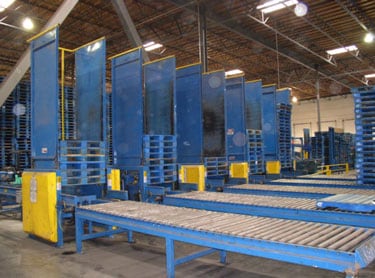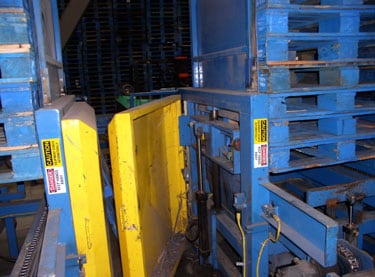An Apprentice Mechanic Died When Crushed In A Machine That Stacks Wooden Pallets
Investigation: # 03CA003
SUMMARY
A 44 year-old Hispanic male apprentice mechanic died when crushed by the hydraulic mechanism of a machine that stacks wooden pallets. At the time of the incident, the victim had the door open that guards the movable hydraulic mechanism and was adjusting the settings on the pallet stacker. The lockout / tagout procedure was not being used by the victim when the incident occurred. The victim had not completed his safety training. The CA/FACE investigator determined that, in order to prevent future occurrences, employers, as part of their Injury and Illness Prevention Program (IIPP) should:
- Ensure that the lockout / tagout procedure is implemented whenever maintenance or repairs are being performed on pallet stacking machines.
- Ensure apprentice mechanics are trained on machine operation and safety prior to hands-on work.
INTRODUCTION
On March 17, 2003, at approximately 8:00 p.m., a 44-year-old apprentice mechanic was killed when he got caught in the hydraulic mechanism of a pallet stacking machine (exhibit #1). The CA/FACE investigator learned of this incident on March 27, 2003, through the Legal Unit of the Division of Occupational Safety and Health (Cal/OSHA). On April 23, 2003, the CA/FACE investigator traveled to the victim’s place of employment where he interviewed company personnel and employees who responded to the incident. The investigator also inspected the incident site and took pictures of the machine involved in the incident.
The employer of the victim was a full service public warehousing and logistics company that had been in business for 25 years. The company had about 1,000 employees, with 150 working at the facility where the incident occurred. The victim had been employed with the company for 5 months. They had a safety program and a written injury and illness prevention program (IIPP) with all the required elements and a formalized training program. Formal safety meetings were held monthly and were documented. Tailgate safety meetings were conducted daily before each shift.
Training was accomplished by utilizing video, booklet, handouts, group discussion, and on-the-job-training (OJT). The training was measured through written quizzes and management observation during the first week of employment. The required training for a specific job was verified by the immediate supervisor’s signature. The victim, an apprentice mechanic, was under the direct supervision of a journeyman mechanic. There was no documentation to verify the victim had received specific training for the task he was performing at the time of the incident. The lockout / tagout procedure was generic in nature and not specific to any piece of equipment.
INVESTIGATION
The site of the incident was a warehouse complex. The facility within the complex where the incident occurred manufactured, inspected, repaired, and distributed wooden pallets. It used a high-speed pallet sorting and stacking machine for this process. The fully automated system took the sorted pallets off a roller conveyor and stacked them to a designated number (1-20) (exhibit #1). The automated system was controlled through a series of electric eye sensors. When the pallet passed the first sensor, the automatic device used to pull the pallet into place was activated. When the pallet was pulled in place, another sensor was activated to start the stacking cycle. The hydraulic stacker lifted the pallet onto lifting dogs, and then went back down completing the cycle (exhibit #4). Lifting dogs are mechanical holding devices that grasp an object (usually on its edge) and hold it in place. A chain mechanism took the pallet into the stacking mechanism and passed another sensor, which counted the number of pallets stacked. When the desired number of pallets was reached, the machine ejected the stack onto the outgoing roller conveyor for removal and storage or shipping (exhibit #2).
On the day of the incident, the victim was performing maintenance on the pallet stacker adjusting the hydraulic stacker mechanism. Access to the lifting mechanism was obtained by opening the guard or door protecting the device. The machine was not locked or tagged out before the victim put his head and chest between the hydraulic ram and the frame of the machine. Evidence suggests the victim completed his adjustment and was reaching inside the mechanism to pick up a wrench he dropped on the floor. While the victim was in this position, he broke the beam that started the machine cycle. When the machine cycled, the victim was unable to get out in time. The journeyman mechanic in charge of the victim came around to check on his progress and saw that he was caught in the machine. He immediately shut off the power and cut the hydraulic lines in order to release the pressure and free the victim. Paramedics responded after being called and treated the victim, then transported him to a local hospital were death was pronounced.
CAUSE OF DEATH
The cause of death, according to the death certificate, was traumatic asphyxiation.
RECOMMENDATIONS/DISCUSSION
Recommendation #1: Ensure that the lockout / tagout procedure is implemented whenever maintenance or repair is being performed on pallet stacking machines.
Discussion: The purpose behind a lockout / tagout procedure is to release any stored energy within a machine, then lock that source out while the machine is being worked on to protect the worker. It also prevents accidental starting of a machine while it is being worked on. A lockout / tagout program with an energy control procedure specific to the equipment involved might have prevented this incident. Even the company’s generic lockout/tagout program, had it been implemented, might have prevented this incident.
Recommendation #2: Ensure apprentice mechanics are trained on machine operation and safety prior to hands-on work.
Discussion: The term apprentice implies that the employee is still in the learning phases of his career. Before any “hands on” instruction takes place, an apprentice should be taught the machine theory, operation, and safety devices before handling a wrench to perform maintenance. This ensures the employer that the employee is aware of his complete surroundings when doing his job. The supervisor should directly observe the employee until the safety training is complete and the employee has demonstrated proficiency. The victim had not completed his safety training at the time of the incident. Employers should also have documentation to measure the effects of training and assure them that the apprentice is proficient in the area trained.
REFERENCES
- California Code of Regulations, Vol. 9, Title 8, Sections 3203, 3314, 3328
FATALITY ASSESSMENT AND CONTROL EVALUATION PROGRAM
The California Department of Health Services, in cooperation with the California Public Health Institute, and the National Institute for Occupational Safety and Health (NIOSH), conducts investigations on work-related fatalities. The goal of this program, known as the California Fatality Assessment and Control Evaluation (CA/FACE), is to prevent fatal work injuries in the future. CA/FACE aims to achieve this goal by studying the work environment, the worker, the task the worker was performing, the tools the worker was using, the energy exchange resulting in fatal injury, and the role of management in controlling how these factors interact.
NIOSH funded state-based FACE programs include: Alaska, California, Iowa, Kentucky, Massachusetts, Michigan, Minnesota, Nebraska, New Jersey, New York, Oklahoma, Oregon, Washington, West Virginia, and Wisconsin.
To contact California State FACE program personnel regarding State-based FACE reports, please use information listed on the Contact Sheet on the NIOSH FACE website. Please contact In-house FACE program personnel regarding In-house FACE reports and to gain assistance when State-FACE program personnel cannot be reached.
EXHIBITS
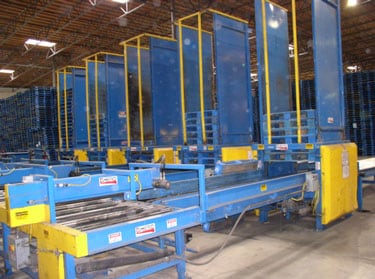 |
|
Exhibit #1. View of the pallet stackers from the front
or loading end. |
|
Exhibit #2. View of the pallet stackers from the rear
or unloading end. |
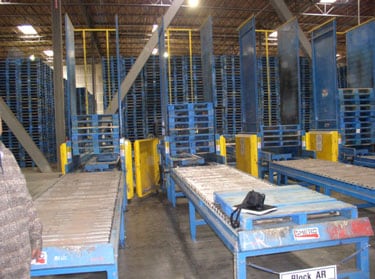 |
|
Exhibit #3. View of the pallet stacker involved in
the incident. |
|
Exhibit #4. View of the hydraulic mechanism and
electronic eyes used in the stacking process. |
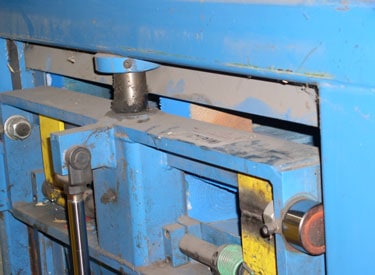 |
|
Exhibit #5. A view of the hydraulic mechanism that
crushed the victim. |
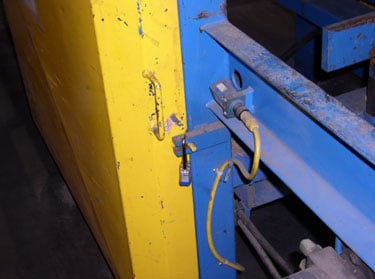 |
|
Exhibit #6. A view of the electronic eye sensor that
activates the hydraulic mechanism. |

